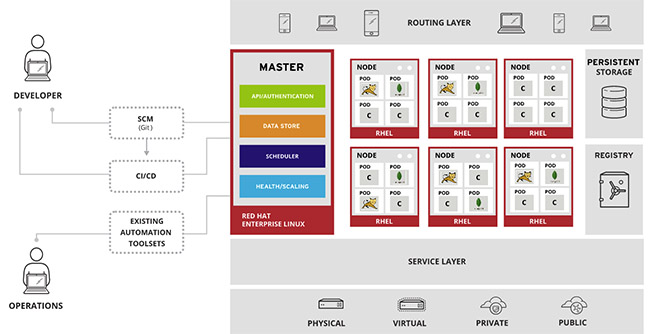Red Hat Breaks Down Barriers to Enterprise Container Adoption with Latest Updates to OpenShift Container Platform
Red Hat’s latest update to its Red Hat OpenShift Container Platform sports features to strike a balance between providing a platform with no-nonsense support for mission-critical workloads, yet giving headroom for creativity and innovation.
Red Hat’s latest update to its Red Hat OpenShift Container Platform sports features to strike a balance between providing a platform with no-nonsense support for mission-critical workloads, yet giving headroom for creativity and innovation.
In specific, Red Hat OpenShift Container Platform 3.4 integrates the architectures, processes and services to enable developers and IT ops teams to deliver a wide range of apps – legacy on-premises, cloud-native and even apps that use distributed containerized workloads, according to Ashesh Badani, vice president and general manager of OpenShift at Red Hat.
“The latest version of our flagship [Red Hat OpenShift Container Platform] goes a step beyond simply creating and deploying applications by addressing the growing storage needs of both stateful and stateless applications across the hybrid cloud. [This allows] for coexistence of modern and future-forward workloads on a single, enterprise-ready platform,” Badani said in a statement.
Red Hat OpenShift Container Platform 3.4 also offers dynamic storage provisioning (for both traditional, hybrid cloud and cloud-native app environments), as well as multi-tenant capabilities and easy-to-execute deployment processes, he added.

Other new capabilities in the latest version of Red Hat OpenShift Container Platform include:
- Next-level container storage. This new support for dynamic storage provisioning allows multiple storage types to be provisioned. Further, Red Hat offers “multi-tier storage” exposure via quality-of-service labels in Kubernetes. Access to container-native storage is also added. This is enabled via Red Hat Gluster Storage, which supports dynamic provisioning and push-button deployment for stateful and stateless apps running on Red Hat OpenShift Container Platform. This enhancement makes the consumption and provisioning of application storage easier for developers to use. [By using Red Hat Gluster Storage, OpenShift customers obtain a software-defined, highly-available and scalable storage solution that works across on-premises and public cloud environments, the company added.]
- Enhanced multi-tenancy. A more simplified way to manage projects is added, letting users search for projects, project details, manage project membership and more via a more streamlined web console. The feature, powered by expanded support for Kubernetes namespaces, allows multiple developer teams, apps and lifecycle environments to run fully isolated and/or share resources on a single Kubernetes cluster in the Red Hat OpenShift Container Platform.
Among other benefits these multi-tenancy capabilities provide includes enabling enterprise IT organizations to provide application development teams their own cloud-like application environment to build and deploy customer-facing apps (or internal apps) using DevOps processes that are isolated from one another. - New hybrid cloud reference architectures. Red Hat OpenShift Container Platform now is compliant and ready runs on all popular cloud platforms -- OpenStack, VMware, AWS (Amazon Web Services) Google Cloud Engine and Microsoft Azure. Pre-scripted guides are now available to help walk a user through how to use Red Hat OpenShift Container Platform to deploy a stable, fault-tolerant, production-grade environment across public and private clouds, virtual machines and bare metal.
Inside Red Hat’s Choice, Support for a ‘Kubernetes Backbone’
Forming the “orchestration backbone” of Red Hat OpenShift Container Platform 3.4 is Kubernetes 1.4, which is maintained by the open source Kubernetes Project community.
Kubernetes 1.4 features alpha support for expanded cluster federation APIs, a feature that can enable multiple clusters federated across a hybrid environment and a capability that Red Hat views as a key component to enabling hybrid cloud deployments in the enterprise. As with all of Red Hat’s enterprise-ready Linux container solutions, the latest version of OpenShift offers community innovation as hardened, production-grade features.
Joe Fernandes, a senior director of product management at Red Hat, explained further Red Hat chose Kubernetes for OpenShift in a recent blog post:
We always knew that OpenShift would need more than a container runtime. As I often like to say, real applications don’t run in a single container and real production applications can’t be deployed on a single host. The ability to orchestrate multiple containers across multiple hosts was a critical requirement for OpenShift. In late 2013 and early 2014 we explored a number of options, including nascent orchestration efforts in the docker community, a thorough evaluation of Mesos and we even experimented with building our own OpenShift-specific orchestration solution. We even heard calls from the Twitterati that Red Hat should embrace other projects instead of OpenShift.
Ultimately our investigation led us to Kubernetes and looking back on it now there are three main reasons why – great technology, a great partner and a truly great community.
Red Hat OpenShift Container Platform 3.4 also contains the Docker container runtime, which helps customers to more quickly roll out new services with the backing of a stable, reliable and secure enterprise platform powered by the latest version of Red Hat Enterprise Linux.
This puts into context the ‘next step’ nature of Red Hat’s latest container platform update.
As Badani put it: “While Linux containers represent an innovative future for enterprise applications, traditional and legacy applications remain critical to the modern business.” He added that with this release, Red Hat wants to help organizations better embrace such Linux containers, and other new technologies, that can deliver innovative business applications and services - without sacrificing existing IT investments.
Red Hat OpenShift Container Platform 3.4 is available now via the Red Hat Customer Portal. Red Hat Cloud Suite will also feature the latest container application platform update as a pre-integrated offering alongside Red Hat OpenStack Platform, Red Hat Virtualization and Red Hat CloudForms.






